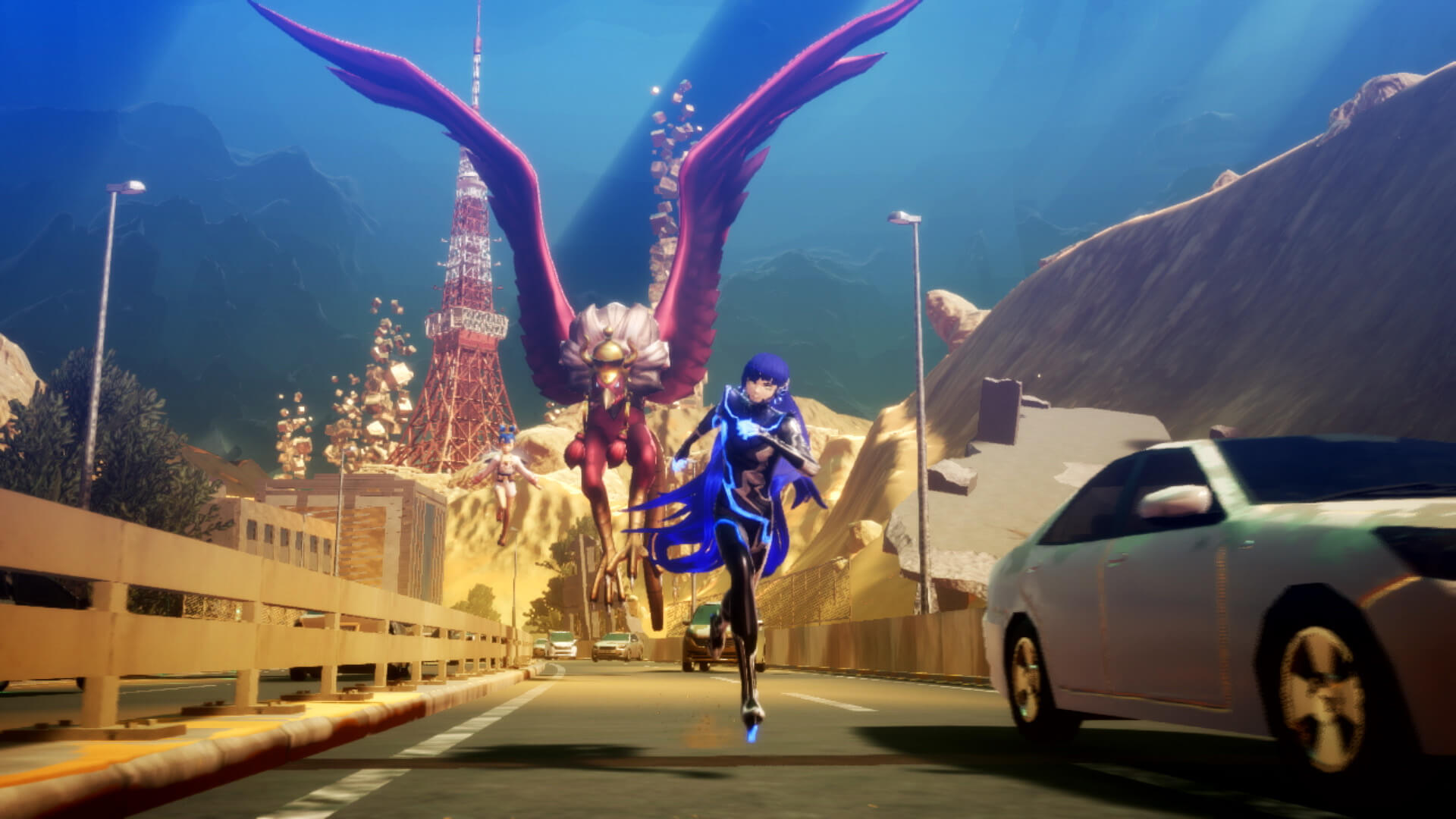The original Shin Megami Tensei V was great. When I reviewed it back in 2021, I loved the challenging combat, the excellent art design, the menagerie of mythological beings, and the overall dark and oppressive atmosphere wherein humanity hangs by a thread. But there was certainly room for improvement, so I was eager to see how Atlus would handle Shin Megami Tensei V: Vengeance, its revised and expanded multiplatform release. So rather than repeat what was said before–much of my original review still stands–it’s more worthwhile to look at Vengeance’s most important changes and new additions. There’s a lot that’s been added and adjusted, so let’s focus on what made the biggest impact on the game overall.
Perhaps the most noteworthy is its performance. Instead of being constrained on the Switch hardware, Vengeance is now multiplatform, allowing the game to run at a much smoother 60fps. Though the Switch version was known to chug when a lot was going on in its big, open environments or in combat, this is no longer a problem. (Since we’ve reviewed Vengeance on PS5, we can’t say if the Switch version still has these performance hiccups, though we do know it aims to run at 30fps.)
Visually, however, Vengeance looks similar to the original; the environments and character models lack the sort of intricate detail you might be used to seeing on current-gen consoles. Still, what Vengeance lacks in ultra-detail it more than makes up for in stunning art design, filling the world with beautiful angels and goddesses, vile demonic hellspawn, and a blend of tarnished wastelands and mysterious, otherworldly constructs.

One of the biggest additions to Vengeance is the titular Canon of Vengeance story path, which you can choose to follow at the game’s earliest moments. (The original SMT V story, Canon of Creation, is still available if this is your first go-around in Da’at.) This take on the SMT V story introduces Yoko Hiromine, a student from a neighboring school who’s trained in exorcism and harbors a grudge against her institution. You won’t have to wait long to meet her, either, as she appears to help not long after your first mini-boss encounter with new demon Glasya-Labolas in the Tokyo ruins while also cleverly introducing the new guest-character combat element in the process.
Yoko’s not alone, either. The Vengeance story brings in a quartet of powerful female demons called the Qadištu who have their own objectives in the ongoing story struggle. Both the presence of Yoko and the Qadištu transform the narrative in unexpected ways. Not only are there additional story scenes and enemy encounters (which help alleviate the slow narrative pace of the original somewhat), but plot beats from the original storyline wind up getting twisted in new and interesting directions.
It’s exciting to see how things play out differently and how these changes reverberate in the story down the line, but even so, it takes a while for the Vengeance story to really diverge from the original. You’re still going to the same places and pursuing similar objectives as the original canon for a good chunk of the game–not a big deal for newcomers, but a bit disappointing for returning players.
The new guest mechanic also helps the presence of the other characters in SMT V’s stories feel more important. Plot-essential characters will join your roster as guests for a certain stretch of the story, where they come with a large set of skills and can be summoned and removed from combat like demons. They don’t take up any slots in your demon stock, can do things demons can’t from the get-go (such as using items), and have a bigger skill selection. However, since they’re story-dependent, they can come and go as the plot dictates, and they lack the customization options, such as stat-boosting incense and skill-bestowing essences, your demon units have. Still, in many combat situations, you’ll be glad to have their extra utility around.
If you’re really into powering up your demon companions, the Demon Haunt that’s newly accessible via leylines will be right up your alley. This is a special area where you can have a nice little chitchat with your demon buddies, usually about perfectly normal topics like how much fun it is to feel poison creep into the blood of your enemies or why it sucks that there aren’t as many humans around to gut anymore. By bonding with your darling little army of sociopaths–through combat, conversation, and even gift-giving–individual demons might call you to the haunt to either give you gifts (like items and essences) or gain stat boosts and additional skills.
You can also hang out with your human pals and your fusion-friend Aogami here and discuss plot-relevant happenings. The Demon Haunt certainly feels like an anomaly, with its cheery music and upbeat atmosphere amongst a bigger setting that is neither of those things, but it’s also nice to have a place to take a break from the terrifying occult conflict happening all around you–and maybe get a little treat as a bonus.
One of the defining features of SMT V was its massive, open-exploration environments, and a host of quality-of-life improvements in Vengeance has made navigating a much more engaging and enjoyable experience. The in-game maps are much more detailed than in the original, and a simple button press gives you a bird’s-eye view of the nearby area, allowing you to better judge the topography. If you played the original, you no doubt experienced the pain of seeing something of interest indicated on the map but not knowing how high up (and often inaccessible from your current position) it was, so these tweaks are a huge help. Also aiding in ease of navigation are the Magetsu Rails: shortcuts that can zip you from one area to another quickly (and back again) once activated. These are most often found in out-of-the-way areas like cliffs, enclaves, and rooftops, reducing the amount of finicky platforming needed when backtracking to previously explored areas (and letting you do sick-looking Jet Set Radio grinds to boot).
Demon NPC companions that find items and areas of interest on the map can now be recruited and used outside of set story events, letting you find lots of random loot drops scattered all over the big areas. Finally–and most notably–you can now save almost anywhere rather than at set save points.
There’s a lot more worth mentioning: More Miracles are available to augment the Nahobino (and you can toggle many of them on and off as you please after acquisition), a whole bunch of new demons have been added to the roster, there’s a mess of new side quests–including interesting little mini-adventures where you take control of a demon and time-limited trials–and demons now have unique “innate skills” that affect everything from skill efficacy to making combat negotiations flow smooth.
Magatsuhi skills have been upgraded dramatically, with both new skills added alongside special skills that require either specific demons or demons meeting certain conditions. Some of these skills are eyebrow-raising in just how good they are, as they can remove enemy Press Turns even in boss encounters, depriving foes of actions. In turn-based combat where strategy revolves around getting more turns and robbing the enemy of their actions, that’s huge.
And that’s something odd about Shin Megami Tensei V: Vengeance: This game felt notably easier than the original. For both the original and Vengeance, I played through the game on the standard difficulty, and Vengeance felt less trying overall. I’m not sure how much of that perceived reduction in difficulty comes from my own experience with the original–knowing enemy weaknesses and where you’ll encounter them gives you a significant leg up–but with the new innate skills, new Miracle buffs, new and extremely helpful Magatsuhi skills, getting extra items and boosts in the Demon Haunt, and the save-anywhere feature, Vengeance is generally nicer to the player. Whether that’s a good or a bad thing is up to your tastes–and, keep in mind it’s always very possible to get yourself absolutely wrecked in a random encounter that goes south quickly, so you still need to play wisely. For those of you who want a bloodbath, the absurd “Godborn” difficulty in New Game Plus will satisfy your need for struggle.
Everything that made Shin Megami Tensei V such a memorable and engaging experience remains in Vengeance, just tweaked and massaged into an even better game. It’s easier to connect to the narrative–having the other human characters in your party and engaging in small talk with them go a long way to making the events happening around them feel more impactful–and the various adjustments to navigation, combat, and demon-herding let you focus more on savoring the dark atmosphere and the strategies of battle. If you didn’t enter the tunnel to the underworld the first time around, this is the perfect opportunity to do so–and if you’re a veteran of the war for the throne, there’s plenty here to bring you back.






